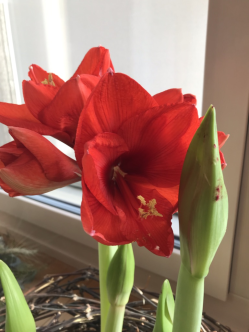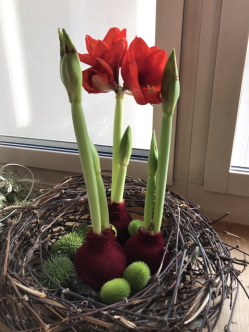Synonyms: amaryllis, Hippeastrum vittatum
Classification of toxicity: toxic
There have not been any known severe poisoning cases in children recently. In the majority of cases, swallowing small parts of the plant leads to mild symptoms or none at all.
Serious symptoms have been described in cases of animal poisoning, usually after eating significant quantities.
Amaryllis (Hippeastrum vittatum; Amaryllidaceae family)
The entire amaryllis plant is toxic, with the highest concentration of toxins being in the bulb.
Toxins: Amaryllidaceae alkaloids.
Occurrence: Highly popular plant in Switzerland in winter and especially the Advent period (as a houseplant in a pot or as cut flower). Originally from Peru.
Characteristics: Typically, amaryllis is bought from major distributors over the Christmas period as a bulb in a pot. With good care, one to two hollow stems will sprout per bulb, reaching a maximum length of 80 cm and typically with three to four large, nodding funnel-shaped flowers in varying colours (single or multi-coloured: red, white, pink). The diameter of the flower is up to 30 cm. The plant also has several long, narrow green leaves.
What should you do in an emergency?
After swallowing:
1) small plant parts (petals, leaves, flower stems)
- Do not induce vomiting.
- Remove any plant remains, wash out mouth.
- Drink 100-200 ml of clear, fat-free fluid,
e.g. water, cordial or tea
2) of amaryllis bulb(s) or larger quantities of plant matter
- Contact Tox Info Suisse.
- Only take activated charcoal following consultation with Tox Info Suisse or a doctor.
After eye contact with sap:
- Remove contact lenses.
- Wash eyes as quickly as possible with clean and lukewarm water for 10 to 15 minutes; when washing, keep the eye open with your fingers.
- If a child is affected: Have someone help them wash their eyes.
After skin contact with sap:
- Wash the affected skin parts with water.
Symptoms
1) small parts of the plant (petal, leaf, stem):Mild and usually short-lasting gastrointestinal symptoms (nausea, abdominal pain, vomiting and diarrhoea).
2) larger quantities of plant matter (particularly plant bulbs):
Pronounced, in some cases bloody gastrointestinal symptoms with serious outcomes are feasible in humans based on outcomes in cases of animal poisoning.
In the event of eye or skin contact with plant sap:
Poisoning is unlikely.

When should you seek medical attention?
In the event of pronounced and persistent gastrointestinal symptoms with multiple (bloody) instances of vomiting or diarrhoea.
Prevention
Without doubt, amaryllis is a real treat for the eyes in the cold winter season. We advise caution in where you place pot plants and cut flowers, especially in households with children and pets or in care homes with dementia patients. We advise placing this plant out of the reach of children and animals (as with all plants) to avoid the risk of accidental ingestion or contact with skin or eyes.
Further information
Amaryllis is toxic to animals:
Serious and fatal symptoms are known in cases where animals (cats and dogs) have eaten amaryllis (parts).
Allergic reactions to amaryllis:
Allergic reactions to amaryllis have been described (particularly in people who, for example, have regular contact with the plant or sap as part of their job).
Further articles on common Advent plants:
Poinsettia (Euphorbia pulcherrima)
Questions about popular Christmas plants: “Year after year”
Frequently asked questions (FAQ)
Tox Info Suisse: No, there is no risk of poisoning. It is sufficient to wash the affected area.
Tox Info Suisse: This is only a small amount. In the worst-case scenario we would only expect mild gastrointestinal symptoms.
Tox Info Suisse: The boy can continue to eat as normal.
Tox Info Suisse: Serious symptoms are unlikely but mild gastrointestinal symptoms may occur. We advise monitoring the resident.
Tox Info Suisse: Fortunately a harmless situation. Although all parts of the plant are toxic, this is just a minimal quantity. We advise washing out her mouth and giving her something to drink. It is highly unlikely that she will get any gastrointestinal symptoms. However, as always, her hands should be washed after coming into contact with plants.
Tox Info Suisse: Harmless.
Tox Info Suisse: Harmless. We advise moving the plant out of his reach. The plant is not suitable as a toy.
Tox Info Suisse: We are aware of cases of serious poisoning in cats, we advise veterinary attention. However, there is no known antidote.
Tox Info Suisse: Symptoms may become life-threatening. We advise seeking veterinary attention immediately. Your vet can then initiate suitable decontamination measures (vomiting, activated charcoal).
Tox Info Suisse: The plant is poisonous, but not extremely poisonous. In this situation, definitely harmless.
December 2023


